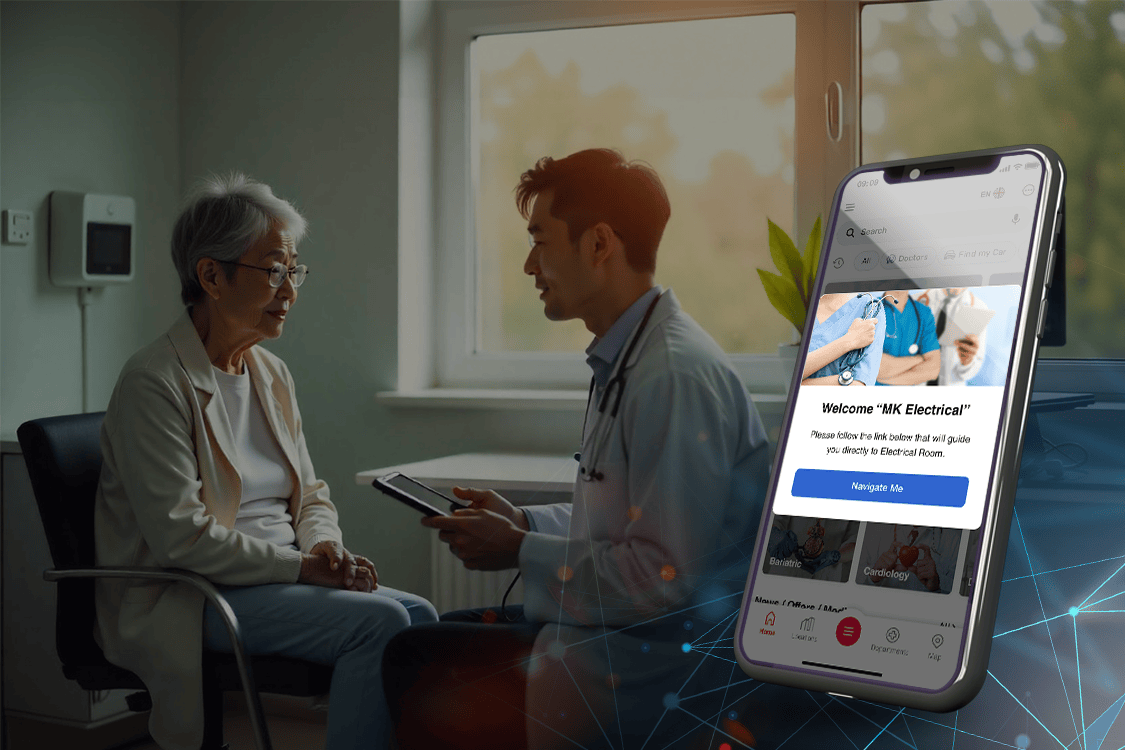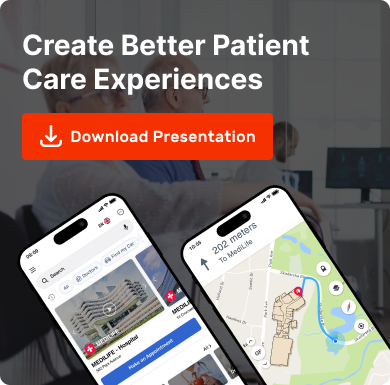Hospitals & Healthcare

Quality health care is not only about diagnosis and drugs. It’s also about how patients move and how they feel and how easily they receive the care they require. Organizations do data analysis today on how people experience care, not just on how it’s delivered. That’s where design, smart tech and location-based tools come together. How healthcare is revolutionizing with design and technology is no longer a future discussion—it’s happening right now. From smarter hospital layouts to real-time location alerts, the patient experience is getting faster, simpler and a lot more personal.
Better Layouts Lead to Better Care
Ever been in a hospital where you had to ask five people just to find the lab? Or a large medical building where patients looked lost, stressed and tired? That’s not good design. And it definitely doesn’t help care delivery.
With patient-centred planning, hospitals are rethinking layouts. Designers now work alongside doctors, staff and patients to make sure each hallway, sign and waiting area works for real people—not just blueprints.


And they’re not doing it alone. Many now use digital healthcare solutions that combine floor planning with behavioural data. These systems can simulate patient flow, identify bottlenecks and show where small changes in design could make a big difference.
This is where wayfinding becomes essential. You give patients a smart digital map on their phone or kiosk. As they move through the hospital, the map adjusts in real time. It guides them to the lab, pharmacy, doctor’s room—whatever they need.
That’s not just smart design—it’s a form of care.
Wayfinding Isn’t a Bonus—It’s a Necessity
In designing for care, you broaden the scope beyond medical tools. You consider how people find things, in particular when they’re under stress, pain or fear. And that’s where wayfinding comes in to be huge.
With digital wayfinding apps, patients don’t have to converse with three nurses just to locate the bloodwork lab. They just follow their screen. These systems are straightforward and visual and they speak the patient’s language — so the experience is serene, time efficient and fluid.
If you want to see how healthcare is revolutionizing with design and technology, this is a great example: you reduce stress, improve punctuality and support staff—all through a simple guidance tool.
Hospitals using digital wayfinding have seen an 80% decrease in wayfinding-related questions, allowing staff to focus more on patient care instead of constantly giving directions.
A real-world example is Boston Children’s Hospital, which introduced the ‘MyWay’ app for turn-by-turn directions inside its complex facility. Within six months, the app had over 4,500 downloads and 65% of users reported a better hospital experience.
Geofencing Makes Every Visit Smarter
Geofencing is another big change. It sets up virtual zones around hospital departments, entrances and rooms. When a patient enters or leaves one, the system knows—and acts accordingly.
Say a patient enters the parking area. The system can notify the front desk, prepare their room or update their caregiver. When they step into the pharmacy, they get a ping about their prescription status.
These aren’t gimmicks. These are digital health solutions that actually improve the way care is delivered.
Hospitals also use geofencing to monitor wait times and flow. If patients are stuck in a waiting area too long, staff can be alerted. That means issues are solved in real time—not hours later.
It also helps track equipment, streamline room turnover and support emergency response.
Design and Tech Together Make Care Personal
Since then, most hospitals have come to understand that technology and design are not elements that can be handled independently. When they collaborate, everything gets more personal. And that’s the essence of patient-centred care innovations — treating patients as humans, not cases.
The app on your phone knows your appointment time, checks you in, shows you where to walk, even to the bathroom (and where the shortest line is). That’s not science fiction. This is already being achieved through the use of location intelligence-powered digital healthcare solutions.
And from the hospital’s end? They receive real-time data on customer foot traffic, service times and resource usage. It enables them to cope better—and to care better.
Cheng Ching Hospital in Taiwan applied space syntax analysis to study how patients moved through their facility. By identifying where people got stuck, they redesigned signage and pathways. The result? Smoother movement, less confusion and better use of space.
Hospitals Are Already Seeing Results
These aren’t just nice ideas—they’re already working on the ground.
- Facilities using geofencing and location tech have reduced patient wait times by nearly 25%
- Staff report smoother operations and fewer repetitive questions, thanks to self-guided navigation
- Missed hospital appointments cost the UK’s NHS nearly £1 billion annually, showing the financial value of getting patients to the right place, on time
If you’re looking at how does technology improve patient care, these numbers say it all.
AI Takes It Further
Now, add AI to this mix and you’ve got a game changer. How is AI revolutionizing healthcare can be reflected in how AI learns from thousands of movements and interactions in your hospital and suggests improvements—like where to add signs or how to redirect foot traffic during rush hours.
That’s how AI is revolutionizing healthcare—not just in diagnosis, but in daily care delivery.
AI also helps personalize alerts, predict delays and manage space use in real time. That means your facility gets smarter the more it operates.
Hospitals using AI-powered geolocation systems report increased staff satisfaction and fewer scheduling delays. It’s small changes with big impact.
It’s About Time, Energy and Respect
Patients don’t want more apps. They want better experiences. They want care that respects their time and helps them feel in control.
So, when you bring together location-aware tools, good design and smart alerts, you’re not adding noise—you’re reducing it. That’s the real win of healthcare technology advancements that focus on experience, not just operations.
Start Simple, Grow Fast
You don’t need to redesign the whole hospital overnight. Start with one building. Add wayfinding. Set up a few geofencing zones. Watch how people move. Listen to what they say.
Then make changes based on real insight—not assumptions.
That’s the smart way to bring in digital healthcare solutions. You’ll see results fast. Patients will feel it. Staff will see it. You’ll know it works.
Final Thoughts
If you want to understand how healthcare is revolutionizing with design and technology, don’t just look at machines or AI reports. Look at how people move. Look at how they feel when they walk in and out.
With the right mix of wayfinding, geofencing and intelligent design, you build care that feels good—not just looks good. And that’s something worth working toward. If you found this blog helpful, please read our blog on “Building the Future of Healthcare: Hospital Design Trends” or watch our video on “Transform Patient Care and Healthcare Facility Efficiencies With Location-Based Technology | Mapsted” to learn more.
Frequently Asked Questions
Q1. How is AI revolutionizing healthcare today?
Ans. AI is helping hospitals streamline care by predicting delays, improving patient flow and managing resources better. It’s a core part of how AI is revolutionizing healthcare beyond just diagnostics.
Q2. How does technology improve patient care in hospitals?
Ans. Technology enhances patient care by minimizing confusion, decreasing wait times and making care delivery more streamlined and customized — from wayfinding apps to geofencing alerts.
Q3. What are digital healthcare solutions used for?
Ans. Digital healthcare solutions are used for appointment scheduling, indoor navigation, real-time alerts and improving how patients interact with hospital spaces—leading to better experiences and outcomes.
Q4. Why are wayfinding systems important in healthcare design?
Ans. Wayfinding enables patients to navigate easily through large facilities. It’ll be a big part of how healthcare’s being revolutionized with design and technology, to help make spaces easier to navigate and less stressful.
Q5. What is patient-centred care innovation?
Ans. Yes, even smaller facilities can benefit from understanding how people move through their space. And it’s not just for big hospitals — better flow benefits us all.
